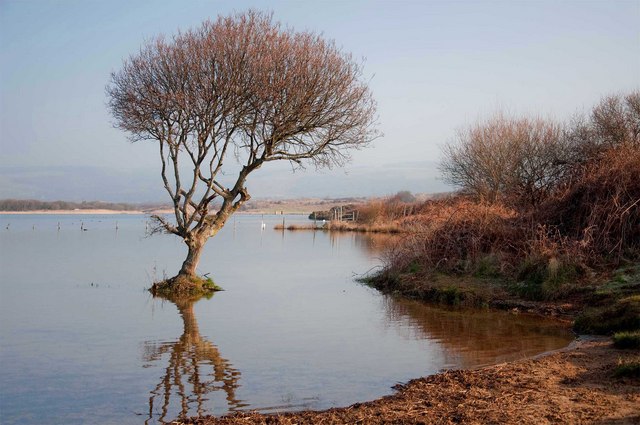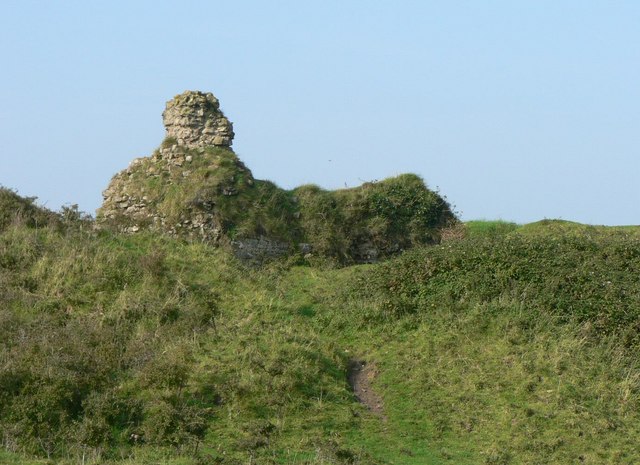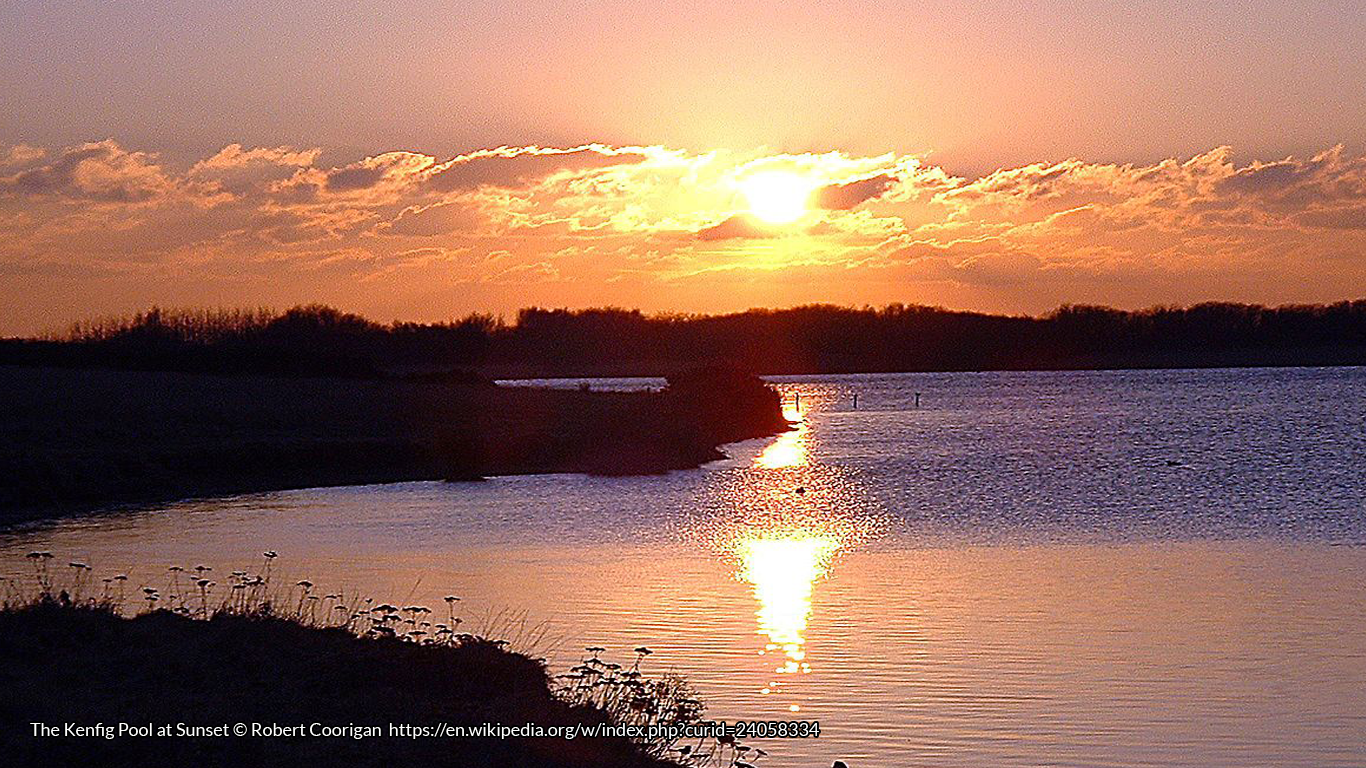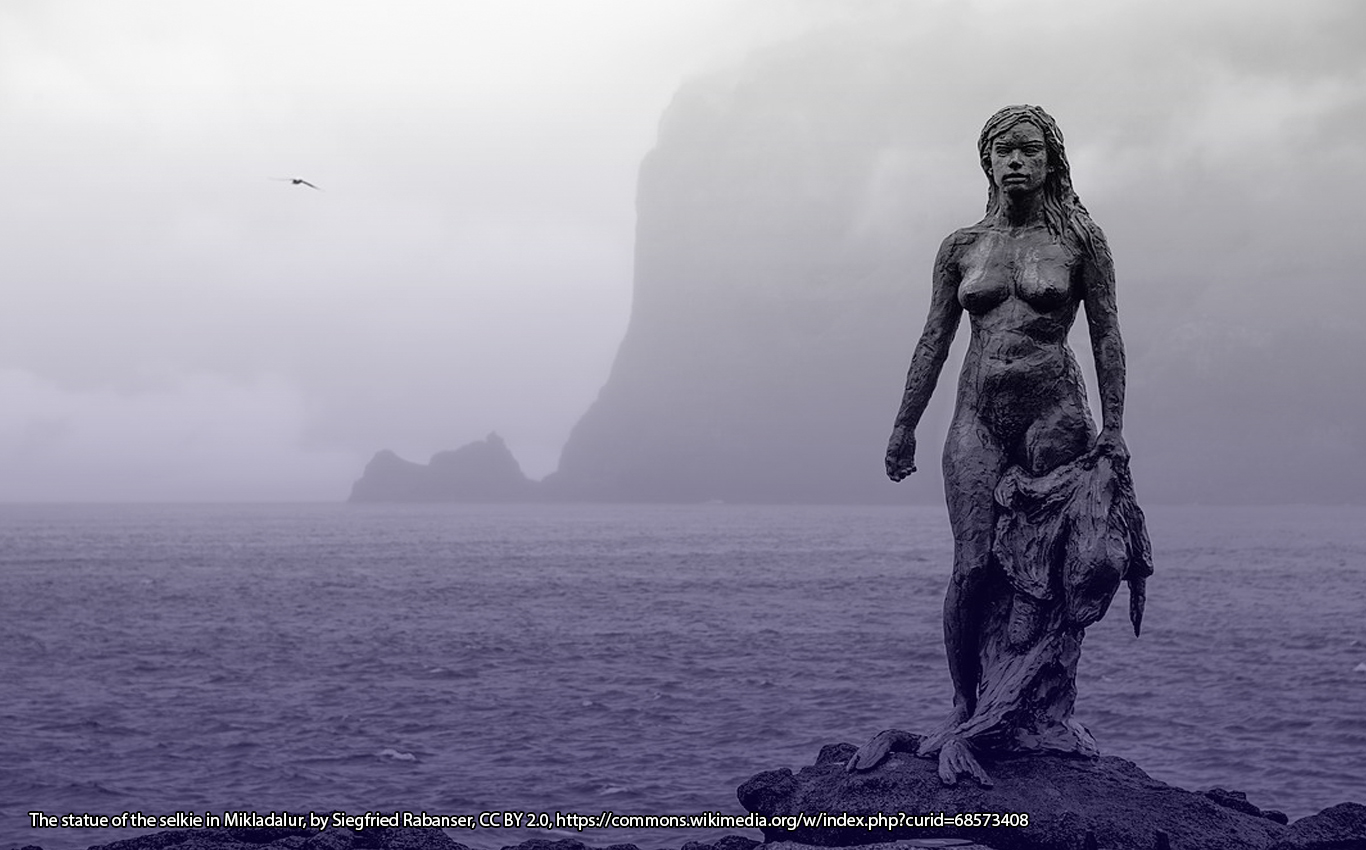Many Welsh lakes have legends and myths connected to them, and Kenfig Pool is no exception having associations with a legendary drowned town under the lake and a real town buried under sand nearby. Situated near Porthcawl, Bridgend in Glamorgan, Wales, it is also known as Pwll Cynffig. There has been a human settlement in this area at least since the Bronze Age, and perhaps because of this long history it is steeped in legend and folklore from many ages. One of the most mysterious is the legend of a drowned town under Kenfig Pool and, adding to the mystique and romance, there was also a real town of Kenfig. This town was abandoned after being completely covered by the shifting sands of a massive dune system which once ran along the Welsh shoreline.
The purpose of this article is to discuss the legendary town supposedly submerged under Kenfig Pool. First, a description of the abandoned town of Kenfig which was known to exist will be provided. This will be followed by a discussion of how Kenfig Pool was thought to have formed, and then the legend that tells the story of the drowned town will be presented and the conclusion will offer a few thoughts to ponder.
The Borough of Kenfig
During the medieval period, the town of Kenfig was situated near the sea and was a borough built around a castle. The burgesses had a charter which gave them the right to make bye-laws and to raise taxes. Kenflig was a prosperous town, with considerable community resources such as a hospital and a guildhall. There were many laws which were designed to ensure a good standard of commodities such as beer, bread, and other foods, and there were controls on weights and measures to ensure fair practice. The Normans built the castle in an attempt to impose themselves on the local people. Although the Welsh sacked the castle several times, it was the forces of nature that finally overcame it. This happened during the 13th century, when powerful storms caused massive quantities of sand to build up along the coastline. The wind carried the sand inland, so that the town of Kenfig and its castle were buried underneath tons of sand. Today, all that can be seen is the top of Kenfig castle which protrudes from the sand.
The Origin of Kenfig Pool
According to one local tradition, an earthquake caused the land to sink and fill with water creating Kenfig Pool. This idea is not supported by experts, and a more modern explanation from Cardiff University claims that before the shifting of the sand, the River Kenfig ran south towards Sker Rocks on the southern part of Kenfig beach and the pool is all that now remains.
Another explanation, supported by a historical document of 1360, tells that a stream called the Blaklaak flowed along the west side of the buried Kenfig town. Another local local tradition says that seven springs fed the pool (but are now believed to have dried up), and the Blaklaak was an outlet for it. Whatever the truth of its origin, the pool was said to be a dangerous place with a whirlpool in the southwest part of it that dragged boaters and swimmers underwater to drown.

The Drowning of the Legendary Town of Kenfig
According to local tradition, the lord of Kenfig had a daughter who fell in love with a young local man of low birth and no money. Still, they say love is blind and the couple wanted to marry. Love may be blind, but the girl’s father was not impressed by the lowly social status and lack of money of his daughter’s suitor, so he ruled against the marriage. He told the couple in no uncertain terms that the young man was not a suitable partner. Filled with despair, the young man decided that the only chance he had of marrying his true love was to leave Kenfig and strike out to another town in the hope of finding or making his fortune. After discussing his plan with his lover, it was reluctantly agreed and he set off alone to find his fortune.
Many months passed by, and he had no luck and was as poor as ever. Feeling despondent and lonely, he decided to return to Kenfig to visit his true love. As he neared the town, he met with the lord’s rent collector who had been out doing his rounds collecting his master’s rents. After completing his rounds, he was carrying a considerable amount of gold and silver back to the treasury.
Realizing that the rent collector was vulnerable and fully laden with money, the young man decided that this could be his chance for riches. He ambushed and killed him, hiding his body and stealing the rent money. The money was a considerable amount, and enough for him to be regarded as very rich and a man of means. He went to the Lord of Kenfig and asked for his daughter’s hand in marriage. His true love was delighted to have him back, and her father was impressed by his wealth and readily gave his consent this time. Although the rent collector had been missed, it was assumed he had run off with his master’s money. No connection was ever made to his disappearance and the loss of the rents and the return of the young man. Plans for the wedding were made and a date set for the happy event.
A Storm Breaks
The couple were married in the local church, and after the service the lord held a lavish banquet to celebrate his daughter’s marriage to such a rich young man of means. As the celebrations were in full swing, a powerful storm broke upon the town and a howling wind swept through carrying a most fearful message. In a terrible voice the wind screamed:
“Vengeance will come, vengeance will come, and vengeance will come!”
This caused the terrified townsfolk to wonder when, and as if in answer the wind howled:
“Ninth generation, ninth generation, with the ninth generation!”
The newlyweds and the frightened people locked their doors and fastened the shutters on their windows, but still they could hear the terrifying screaming voice all through the night. They all took comfort in the thought that they would almost certainly be dead before the time of vengeance arrived. As is the way of storms, this one gradually subsided and was eventually forgotten about.

The Ninth Generation Arrives
The couple settled down and lived a very long and happy life together. They outlived all the other townsfolk by many years and had many children, who also had many children and more generations were produced and a great dynasty was built. At last, the ninth generation was welcomed into the world with the birth of a baby boy. The couple had now reached a great age, and as the proud progenitors of nine generations. They decided to hold a lavish celebration for the birth of the boy. As the celebrations were in full swing, a terrible storm broke over the town lashing it with sheets of rain. The fearsome wind returned, screaming through the streets: crying
“Vengeance is come! Vengeance is come! Vengeance is come!”
The Drowned Town
The storm raged all night; the rain fell in torrents and the voice howled out its message. Vengeance fell heavily upon the town, and as the sun rose the storm eventually subsided. As people who lived outside the town and worked or had business inside it made their way to Kenfig, they were astounded to see that where the town once stood there was now a vast, still, pool of water. The only signs of the town that remained were three chimneys protruding from the water, still belching out plumes of black smoke. Local legend tells that the appearance of these chimneys was often the prelude to storms at sea, that would cause the deaths of local sailors. It is also said that the distant, dismal tolling of the church bells can be heard drifting across the water at times.
The Sins of the Father
Maybe the bells toll for the innocents of the town who were drowned along with the proud progenitors of a great dynasty. The long-lived couple lived to bear witness to the drowning of the entire line of their descendants, all of whom appear to have paid the price for their forefather’s sin. Is there some hidden message or moral in this? Are the sins of the father really the sins of the son, or is the legend of the drowned town of Kenfig Pool just quaint story to tell the children?
For full versions of these Welsh lake legends and all articles in this series, visit the Folklore of the Welsh Lakes page or select from the list below:
- The Legend of Lake Bala, Wales
- The Legend of the Bride from the Red Lake
- Llyn Cwm Llwch and the Door of the Tylwyth Teg
- Llyn Barfog, the Female Dwellers of Annwn and King Arthur and the Afanc
- The Legend and Legacy of the Lady of Llyn y Fan Fach
- Reflecting on Faerie Brides, Drowned Towns, and the Otherworld






![Boadicea, leader of the rebellion against the Romans. By Joseph Martin Kronheim (1810–96)[1] - This file has been extracted from another file: Pictures of English History - Plates I to IV.jpg, Public Domain, https://commons.wikimedia.org/w/index.php?curid=12705208](https://folklorethursday.com/wp-content/uploads/2020/10/Pictures_of_English_History_Plate_IV_-_Boadicea_and_Her_Army.jpg)




